The State of Cross-Channel Marketing in the Food & Beverage Industry
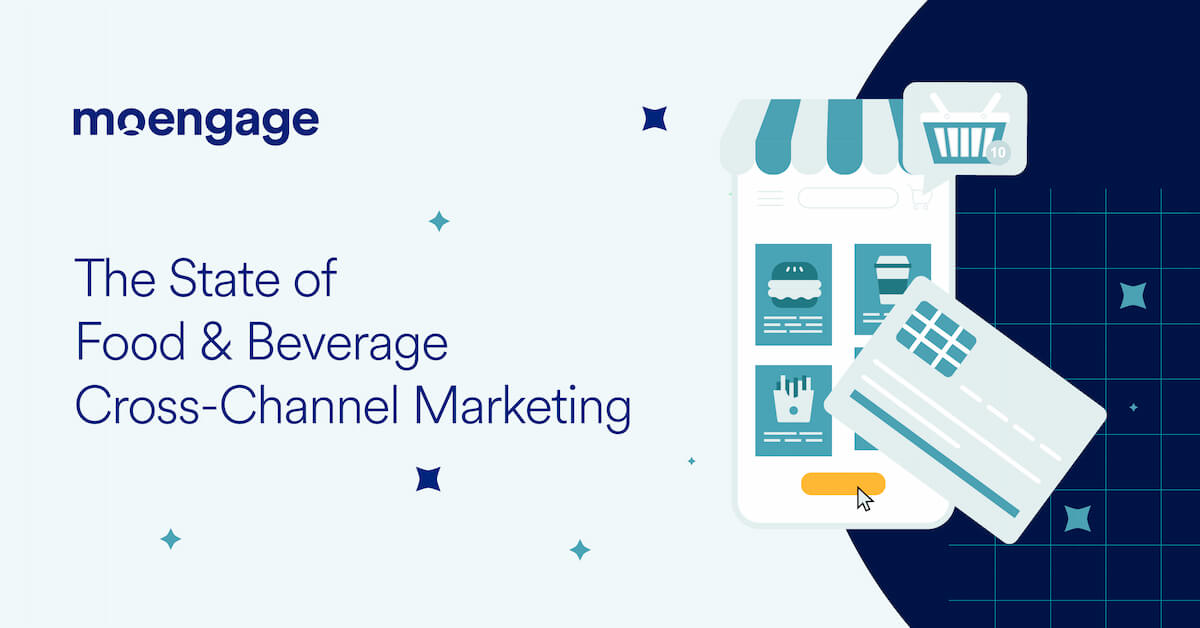
Reading Time: 8 minutes
Anyone familiar with the Food & Beverage industry knows that with ever-changing consumer preferences, brands in this space face a unique set of cross-channel marketing challenges.
In our recent State of Cross-Channel Marketing survey and report, we found that Food & Beverage brands are experiencing difficulty with executing cross-channel communications, leveraging their data to deliver personalized experiences, and attributing marketing performance.
And despite their focus on increasing customer engagement and loyalty in the next twelve months, investment in modern customer engagement technology is lagging with spreadsheets acting as the main software of record for these types of marketing activities.
Here, we’ll take a look at the specific responses from Food & Beverage marketers to unearth the most frequently used engagement channels, the top blind spots they encounter when executing cross-channel marketing campaigns, and some of the best practices they can deploy to drive success.
Let’s jump in.
Who We Surveyed: Methodology + Demographics
Responses We Analyzed:
- All Responses: 730
- Food & Beverage: 47
Roles and Company Size
The majority of respondents said they are a Team Lead (31.9%) with 42.6% saying they are Director/Management or another C-Level executive. In terms of company size, 72.2% of respondents represent companies with more than 200 employees.
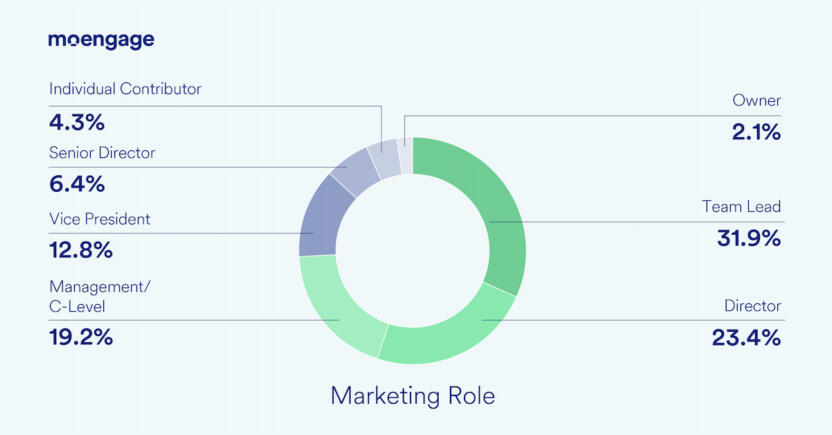
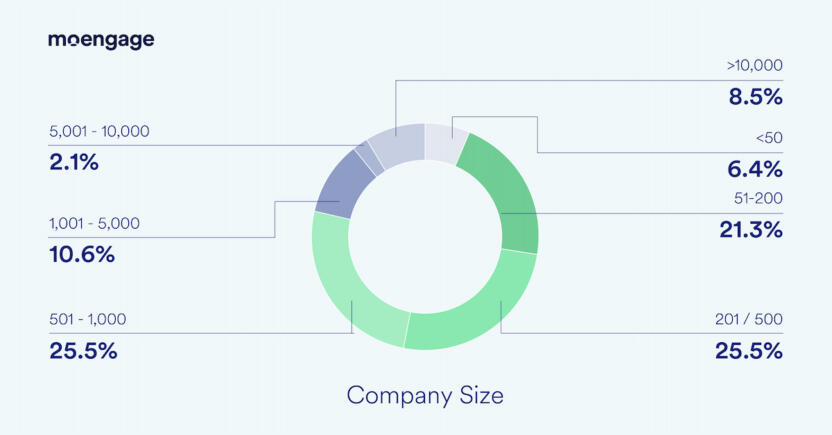
Channels
According to our broad set of survey results, the most popular engagement channels that B2C marketers use are:
- Email (89.6%),
- Social Media (80.3%),
- Desktop Website (67.1%),
- Mobile Website (65%),
- Mobile App (49)%
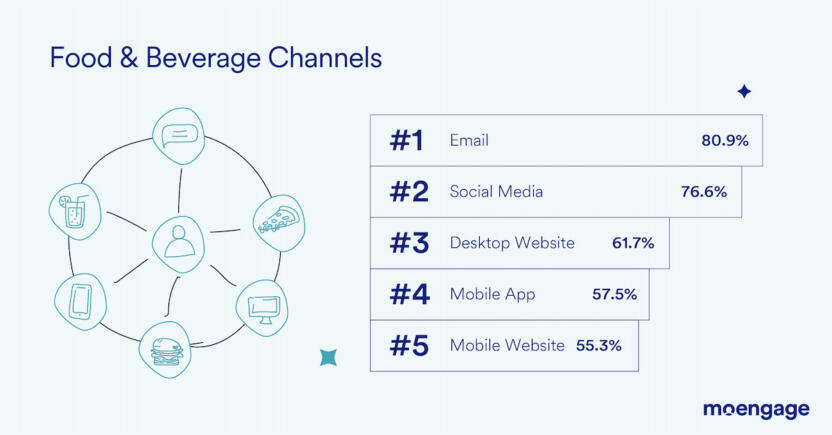
When looking specifically at the Food & Beverage industry, we found that these brands follow suit for the most popular channels they use until we get to the fourth spot. Instead of a greater focus on Mobile Website usage, brands in this space are more likely to use a Mobile App to engage and communicate with customers.
In the Food & Beverage industry, brands often give more importance to mobile apps rather than mobile websites for a few key reasons. Let me break it down for you:
First of all, mobile apps provide a top-notch user experience with features like personalized recommendations, loyalty programs, and easy ordering, which really make customers happy and engaged.
Secondly, mobile apps are super convenient – customers can access menus, place orders, and get all the info they need with just a few taps on their smartphones. Plus, brands can send personalized push notifications directly to users, keeping them in the loop about special offers and events, which is a great way to boost engagement.
And let’s not forget about loyalty programs! Many brands have these integrated into their mobile apps, making it easy for customers to earn rewards and enjoy exclusive deals. Having a dedicated mobile app also helps Food & Beverage brands establish a unique brand identity and stand out from the competition.
While mobile websites are still important for providing information, the focus on mobile apps in this industry is all about delivering a personalized, convenient, and engaging experience to customers.
Objectives
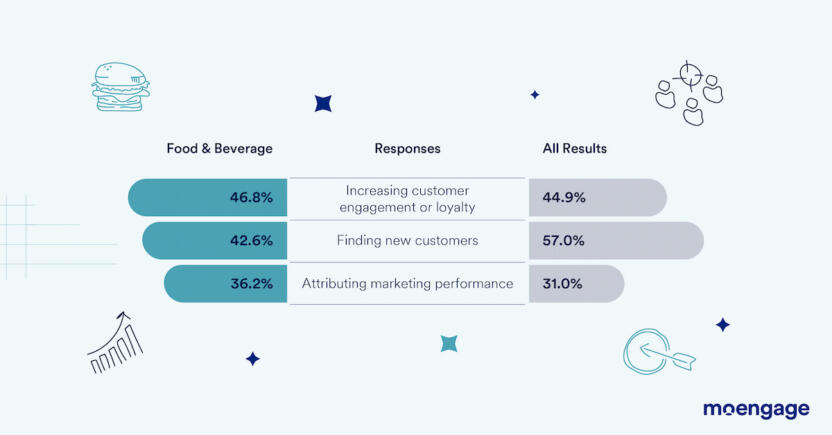
When it comes to Food & Beverage brands, they have a unique focus compared to the general population of respondents. While finding new customers is still important (42.55%), these brands put slightly more emphasis on increasing customer engagement and loyalty (46.81%).
They understand that building strong relationships with their existing customer base is key to long-term success. That’s why they prioritize strategies that foster customer engagement, such as personalized marketing campaigns and loyalty programs. They want to create experiences that keep customers coming back for more.
Interestingly enough, Food & Beverage brands also prioritize attributing marketing performance as a key objective. In a competitive industry like theirs, it’s crucial to ensure that their marketing efforts are effective and generating a positive return on investment. By measuring and analyzing the impact of their cross-channel marketing activities, they can optimize their strategies and make data-driven decisions to drive revenue growth.
These priorities stem from the unique dynamics of the Food & Beverage industry. With changing consumer preferences and evolving food and beverage trends, these brands need to stay agile and responsive. By focusing on customer engagement, loyalty, and marketing performance attribution, they can adapt quickly to market shifts and maintain a competitive edge.
AI Usage
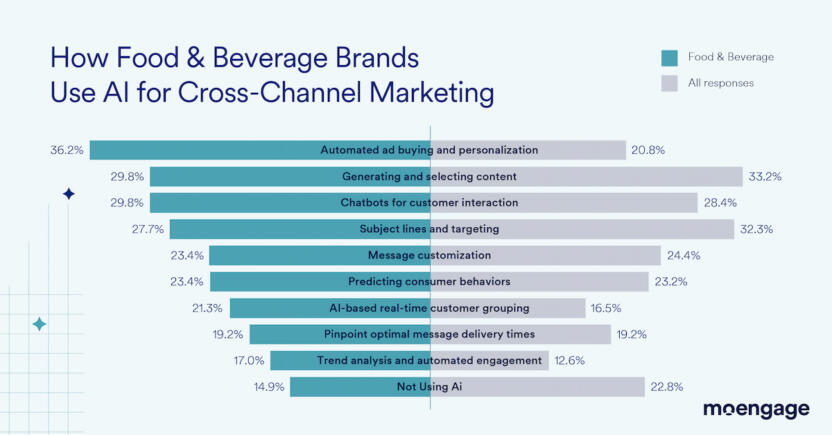
Based on the graph, you can see that, when it comes to AI in cross-channel marketing for Food & Beverage, a few interesting things stand out. This group is using AI at a higher rate than the general group (14.9% are not using AI as compared to 22.8%), and their key use case is:
- “AI for automated ad buying and personalization”
But why might this be the case?
Well, as noted earlier, the Food & Beverage industry is highly competitive, with numerous brands vying for consumer attention. To stand out in this crowded market, companies are turning to AI-powered technologies for automated ad buying, allowing them to optimize their advertising campaigns and reach the right audience at the right time.
In addition, customer expectations are on the rise. Consumers today want personalized experiences that cater to their preferences and needs. In fact, according to our recent Personalization Pulse Check Report, 58% of consumers are frustrated with brands that offer generic and inconsistent communication.
That’s where AI comes in.
By leveraging AI for personalization, marketers in this industry can analyze vast amounts of customer data to understand individual preferences, behaviors, and purchase patterns. This enables them to deliver personalized recommendations, offers, and promotions across various channels, creating a more engaging and tailored customer experience.
This level of personalization builds stronger connections with customers and increases the likelihood of repeat purchases.
Also, AI can help companies stay ahead of these trends by analyzing market data, social media conversations, and consumer feedback. This allows them to identify emerging trends and adapt their marketing strategies accordingly, ensuring they remain relevant and appealing to their target audience.
Challenges
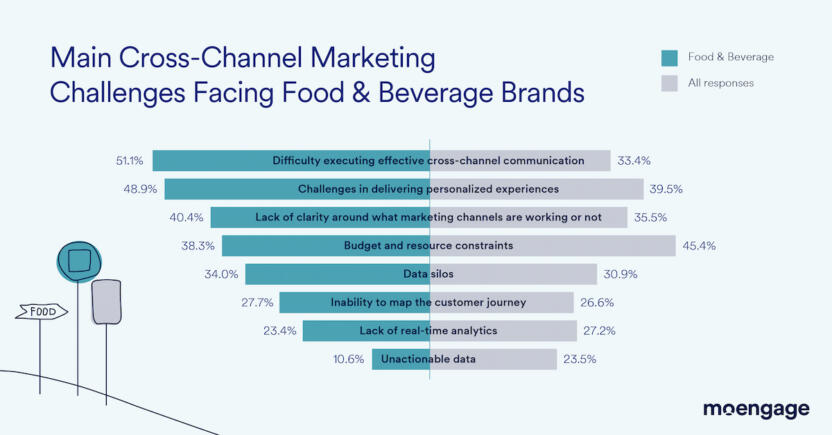
According to the survey data, Food & Beverage brands are struggling to execute effective cross-channel communications at a higher rate than the general group of respondents.
To dig into this further, similar to within the Ecommerce & Retail industry, the customer journey in the Food & Beverage industry is often fragmented, with multiple touch points like online platforms, social media, mobile apps, and physical locations. Coordinating and delivering consistent messaging across these channels can be challenging, especially when there’s a lack of integration or synchronization between them. This fragmentation can make it difficult to execute seamless cross-channel communications.
Another factor is the complex operations that Food & Beverage brands often have. With multiple locations, franchises, or delivery partners, coordinating messaging and ensuring consistent brand communication can be a logistical challenge. The complexity of operations can result in inconsistent messaging or disjointed customer experiences, impacting the effectiveness of cross-channel communications.
Limited resources can also contribute to the struggle. Smaller Food & Beverage brands may have constraints in terms of budget and personnel, making it challenging to develop and implement comprehensive cross-channel strategies. This limitation can affect the effectiveness of communication across channels.
Finally, compliance and regulatory requirements play a role. The Food & Beverage industry is subject to various regulations, such as food safety and advertising guidelines. Ensuring compliance while maintaining consistent messaging across channels can be a challenge. Brands may face limitations or restrictions in their communication strategies, impacting their ability to execute effective cross-channel communications.
Technology
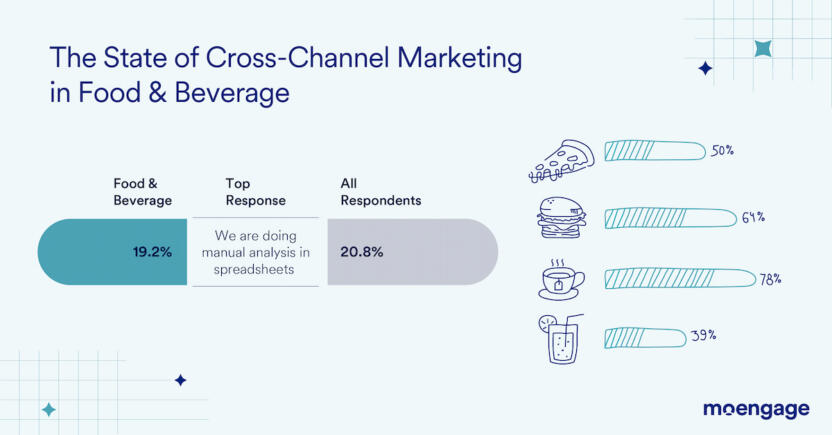
According to our survey, a high percentage (19.15%) of Food & Beverage brands rely on spreadsheets to manage their customer engagement programs. In fact, this was the number one response.
However, relying solely on spreadsheets to handle customer engagement programs might not be the best approach. Spreadsheets have their limitations when it comes to scalability, collaboration, and automation.
As customer data grows, spreadsheets can become a bit of a hassle and prone to errors. They don’t offer real-time updates and fail to provide a complete picture of customer interactions. On top of that, spreadsheets require manual data entry and lack the automation capabilities that are crucial for efficient customer engagement.
That’s why it’s worth considering investing in a dedicated Customer Engagement Platform (CEP). Such a platform can streamline processes, enhance collaboration, and offer advanced analytics for better decision-making and personalized experiences.
Best Practices
The top response regarding the key factor for a successful Food & Beverage cross-channel marketing strategy was the utilization of customer data analytics to make targeted marketing decisions.
By analyzing customer data, businesses gain valuable insights into behaviors, preferences, and trends. With this knowledge, they can develop strategies that effectively engage customers and provide personalized experiences, ultimately fostering customer loyalty and retention.
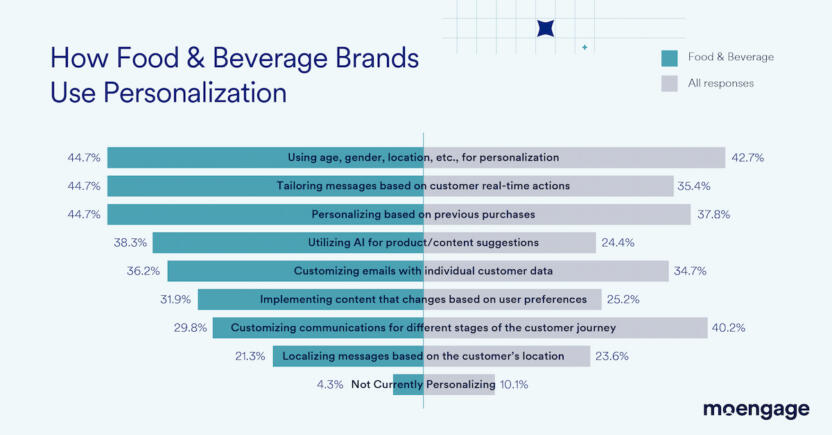
From the responses we gathered, it’s evident that Food & Beverage brand marketers are implementing more sophisticated personalization strategies compared to the general group of respondents.
In addition to basic tactics like utilizing age, gender, and location, they are taking it a step further by customizing their messages, personalizing based on previous purchases, and leveraging AI for product and content recommendations at a higher frequency. It’s worth noting that a mere 4.3% admitted to not utilizing any form of personalization at all.
There could be several reasons why Food & Beverage brand marketers are adopting more advanced personalization strategies compared to the general group of respondents.
As we discussed earlier, with a wide range of products and a diverse customer base, Food & Beverage brands often have access to rich customer data, including purchase history and preferences. This valuable information enables them to tailor their messages and offerings more effectively, creating a more personalized and relevant experience for their customers.
By leveraging advanced personalization tactics, brands can stand out from the crowd, build stronger customer relationships, and ultimately drive customer loyalty and repeat business.
Also, advancements in technology, such as AI and machine learning, have made it easier for Food & Beverage brands to implement personalized strategies at scale. These technologies can analyze vast amounts of data and provide real-time recommendations, allowing brands to deliver personalized content and product suggestions to their customers more efficiently.
Food & Beverage Cross-Channel Marketing: Closing Thoughts
In the dynamic Food & Beverage industry, brands that use AI effectively, maintain compliance while delivering a consistent brand message, and create highly tailored customer experiences will maintain a competitive edge. This is why it is critical to adapt to emerging trends and technologies.
Using a Customer Engagement Platform (CEP) like MoEngage can provide you with the tools and insights you need to achieve your cross-channel marketing objectives.
MoEngage offers a range of solutions that can help Food & Beverage companies improve their cross-channel communication. With 2.2 billion experiences delivered monthly across multiple channels, you can ensure that your message reaches your customers effectively.
Additionally, MoEngage enables you to deliver personalized experiences, leading to a 12% increase in retention with unique 1:1 experiences. By understanding your customers’ preferences and tailoring your communication accordingly, you can build stronger relationships and drive loyalty.
Finally, our analytics and reporting suite provides brands with a holistic view of their cross-channel marketing programs, allowing them to see which channels are working and which are not so they can optimize with ease.
Schedule a demo today to see how MoEngage can help your Food & Beverage business thrive.










